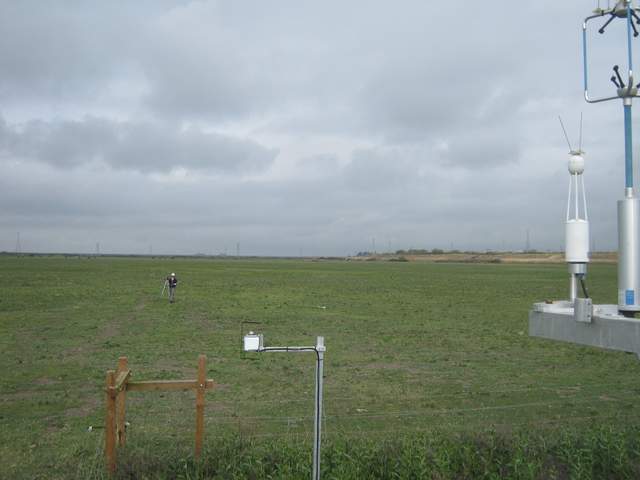Field Notes
<--2013-03-21 09:30:00 | 2013-04-05 09:30:00-->Other sites visited today: Mayberry | Twitchell Rice | West Pond | DWR Corn
Phenocam link: Searching...
Sherman Island: 2013-03-28 09:30:00 (DOY 87)
Author: Cove Sturtevant
Others: Sara
Summary: Spring is here! New pepperweed and wasp activity. Regular fieldwork. All generally well. Rain gauge might have incorrect calibration.
| Sherman
2013-03-28 We arrived about 09:30 PDT. It was calm and cloudy, about 14 °C. The ground under the bridge on the way in remains cracked and dry, and the water in the ditches very low. Spring has arrived. The pepperweed has started growing outside the instrument enclosure, although the plants are only about 20 cm high versus a meter high inside the enclosure. There is a lot of old plant material remaining inside the enclosure while there is relatively none outside. Sara and I debated on whether the cows eat the pepperweed when they run out of grass (I argued for eating, Sara argued for trampling as the means for the pepperweed disappearance). The USDA "Field Guide for Managing Perennial Pepperweed in the Southwest" indicates cattle will graze on new pepperweed growth but cease grazing after the plant flowers (http://www.fs.usda.gov/Internet/FSE_DOCUMENTS/stelprdb5410120.pdf). On the surface, this might seem to prove me wrong, but there was no report for Sherman Island specifically so this strain of pepperweed could be particularly delicious… After our stimulating debate about cow dietary preference, Sara got to making soil respiration, spectral, and moisture point measurements while I checked the tower, downloaded data, cleaned the flux and radiation instruments, and took well depth measurements. The wasps and spiders are also on the springtime up and up. I knocked out wasp starter nests on the lip of the wooden box and inside both water wells. I also knocked out the giant old nest in the end of the radiation boom, which wasps had started building on anew. I shoved some wadded up paper in the end of the boom to hopefully discourage a new nest. LGR readings: 08:34, 21.26 °C, 135.0 Torr (adjusted to 145 Torr), 16.80 us, 10 Hz, 2.0 ppm 7500 readings: CO2: 17.44 mmol m-3 H2O: 586 mmol m-3 diag: 248 sos = 342 m s-1 p = 101.88 kPa MET looked good. Soil CO2 looked good. Last week Susie and I ran 16 fl. oz. of water through the TE525 rain gauge which should have recorded 10 mm of rain. I checked the MET measurements for the full 2-half hours in which the test was run (note last week I reported only the first half-hour). At 0900 on 3/21, 10.16 mm of rain was recorded. At 0930, another 12.47 mm of rain was recorded. This is troubling, as we recorded 22.63 mm of rain when we should have recorded 10 mm. There may be an incorrect calibration inside the logger or at the rain gauge. We should run the test again to confirm and also compare the rain record at Sherman to a local weather station. Update: I checked the datalogger programming and it appears the calibration is set for an english unit versus a metric unit. Backing out the raw number converts to 93 tips of the bucket, which is pretty close to the 100 tips we were expecting. We will re-perform the test, but it looks as though the problem is a programming error (and all the rain measurements since this program was implemented are over twice what they should be). |
1 photos found

SI_autocam_20130328_0915.jpg ( 2013-03-28 09:15:03 ) Full size: 1920x1440
Sara in the field
7 sets found
No data found for SI_mp.
11 SI_met graphs found
Can't check SI_mixed
2 SI_mixed graphs found
4 SI_flx graphs found
3 SI_soilco2 graphs found
Can't check TWSI_mixed
Can't check SIMBTWEE_met

